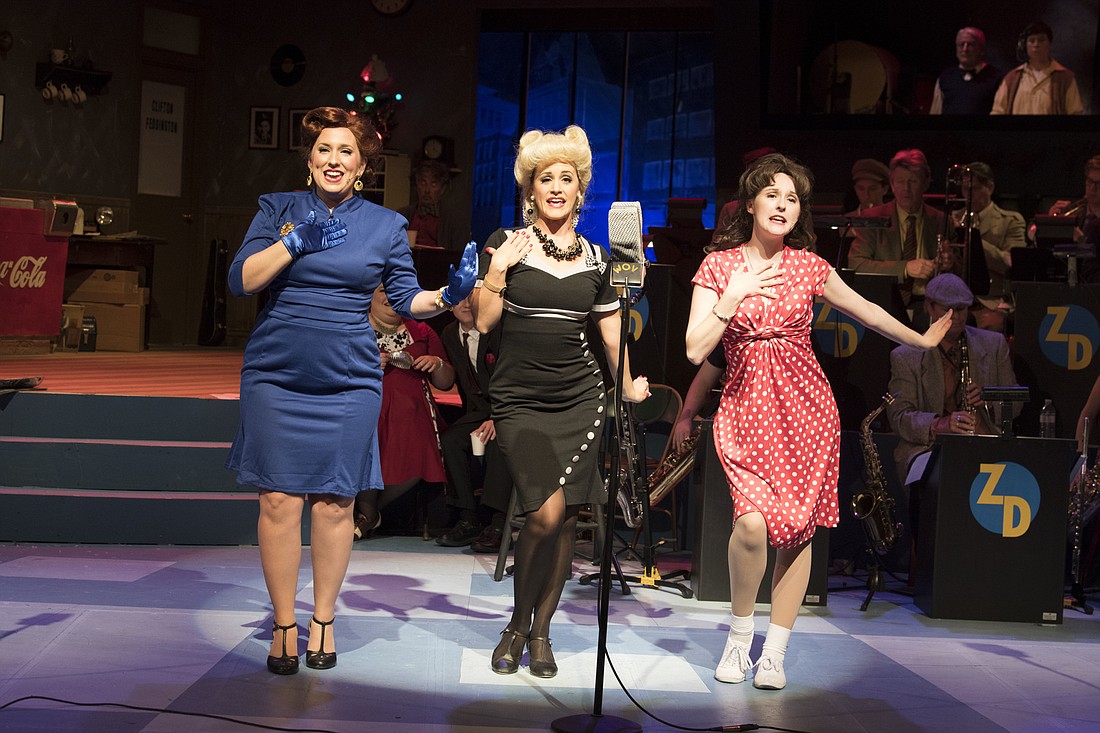- November 23, 2024
-
-
Loading

Loading

It’s chaos. People are yelling, a phone is ringing, trumpets are blaring, light bulbs are being replaced, someone is locked out — and there’s only a few minutes until showtime.
“The 1940’s Radio Hour” isn’t a traditional holiday show. The focal point is not a twinkling Christmas tree that grows taller when the clock strikes midnight. Instead, the play is set in the Hotel Astor’s Algonquin Room in December 1942, where The Mutual Manhattan Variety Cavalcade is about to go on air, and the big band in the pit is as much center stage as the actors above them.
Music Director Alan Corey perhaps explains the premise of the show best.
“The (radio) audience at home only hears what’s right in front of the mic and what they’re supposed to hear, but this audience will see all the rest of the mayhem that goes on behind all that,” he says. “Which makes the show unique because everything is very well staged on purpose so the audience sees exactly what we want them to see.”
Corey says The Players Centre for Performing Arts is always looking for the perfect holiday show, and this year it found it. The Players team had been interested in doing “The 1940’s Radio Hour” for many years, but the challenge was finding the money to organize the full period-appropriate big band for which the show was written.
Pine View School Director of Bands Victor Mongillo says a true big band consists of five saxes, four trombones, four trumpets and a rhythm section. So, after agreeing to play the trumpet in the Players production, he had the “crazy idea” to let his students fill out the sections and make the pit a true 1940s-style big band.
The resulting band consists of five professional musicians each leading a section of high school students from the award-winning Pine View Jazz Band. Corey says there hasn’t been a community theater production of “The 1940’s Radio Hour” boasting a 16-piece band since he started doing theater here in the 1980s.
“I started thinking — these kids can handle these Broadway books,” Mongillo says. “I thought, what an amazing opportunity for them to play music from this bygone era that we just don’t get to do anymore.”
The book is definitely a challenge — the students had to learn 20 songs — but he says his students are used to playing charts and learning jazz-era books, so he felt comfortable offering the opportunity to any jazz band member who could commit to the rehearsal and performance schedule.
And their professional counterparts are fully embracing it. One section leader has even visited Pine View multiple times to work with her musicians at school, Corey says.
“We hit the jackpot when Vic signed on to do this show,” he says. “Absolutely. The cast was really excited about it.”
Enthusiasm seems to be the theme of this show, especially for actor Lindsay MacConnell. Upon hearing The Players decided to put it on, she called Corey to say she would play any role available.
MacConnell played Connie in the Manatee Players production of “The 1940’s Radio Hour” 16 years ago with Corey, and now she returns as the role of Ginger.
And she’s not the only one who already knows the show. All five section leaders were in the Venice Theatre production, along with cast member Bill Sarazen.
Why do actors return to this show? Corey says it’s a fun, spontaneous production that encourages improvisation.
“We get to goof off quite a bit onstage because we don’t have to sit silently while we wait for the next piece to start,” he says, because the show is essentially one straight live music broadcast and the only breaks are for live commercials. “You can see it several times and always see a different show.”
This show also attracts singer-actors whose lack of expertise in dance keeps them from adopting the “triple threat” label, but they still want a musical theater experience. Corey says the production team had a pre-audition strategy of looking for character singers.
And those character singers needed to have a strong voice.
“The singing was really tricky to cast because basically if it’s a song in four-part harmony, there are four people and the parts are all super close together,” Corey says. “If you look at the score they’re all black clusters of notes.”
Corey noticed after working with each singer one-on-one before group rehearsals began that all were confident and excited to have the opportunity to sing something challenging.
They nailed it the first time they rehearsed it as a group, he says.
Mongillo and Corey agree that for all the young people in the show — musicians and actors alike — this opportunity is an introduction to a style that is quickly losing its following.
“Music was what brought those people together,” Corey says of 1940s culture. “They made recordings and sent them over to the soldiers overseas. It was a great bonding experience.”
Mongillo says he feels it’s his responsibility to help keep the legacy of jazz music alive, just as his band director at Sarasota High School, Andy Wright, did for him.
“All of these songs tell a story, they really do, and most music doesn’t contain that anymore.”